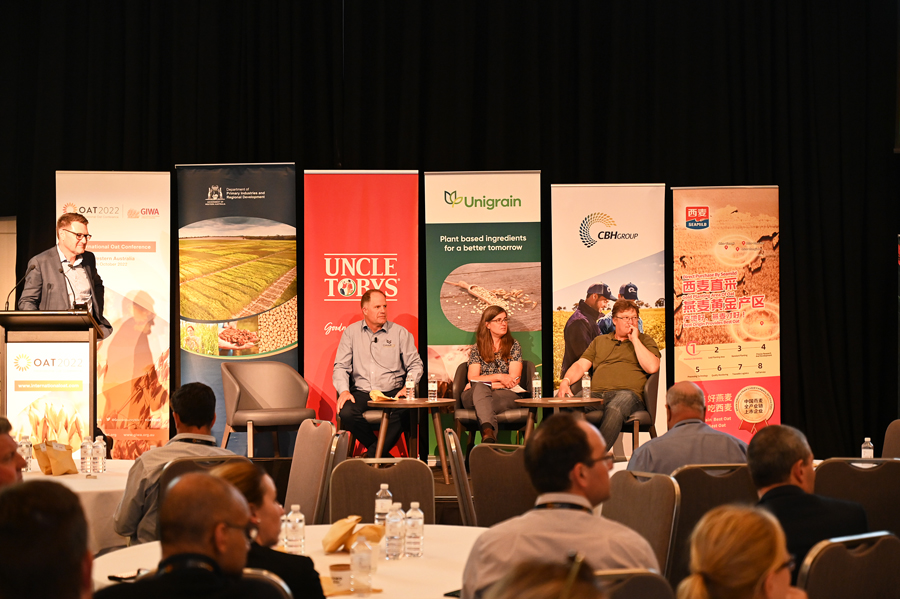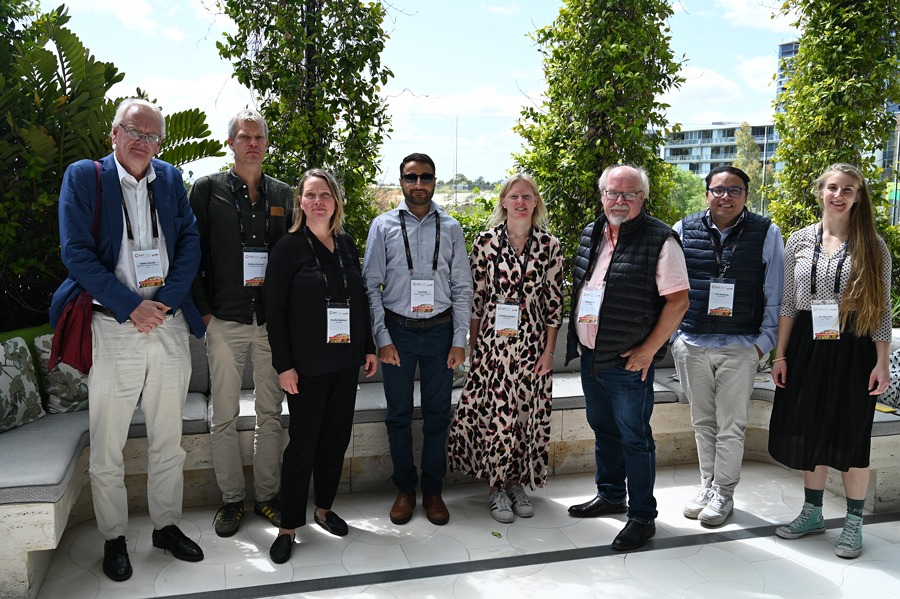Oat experts gathered at the International Oat Conference in Perth in October 2022 to discuss the latest oat developments with a focus firmly set on the crop’s ability to address expanding dietary health needs.
With a shift to plant-based diets and escalating incidence of lifestyle diseases such as obesity and type 2 diabetes around the world, the health benefits of oats are increasingly coming under the spotlight.
Historically, oats have been consumed as a wholegrain cereal, which has many benefits. They are high in fibre, particularly beta-glucan – which contributes to oats’ satiety effect – and bioactive compounds such as polyphenols and vitamins.
These attributes are driving global interest and research and development investment in oats as a healthy food. They were put squarely on the agenda for the 11th International Oat Conference held in Perth from 10–14 October 2022. This theme was complemented by sessions on oat markets, oat breeding and genetics, crop protection and agronomy.
Health
Presentations were made on a broad spectrum of oat health attributes, beginning with a plenary on the potential of oats in diets for coeliacs delivered by Associate Professor Jason Tye-Din from the Walter and Eliza Hall Institute and the Royal Melbourne Hospital.
Oats may have been falsely grouped with wheat, barley and rye as containing the causative antigen gluten and there have been lingering safety concerns about including oats as part of a gluten-free diet. Associate Professor Tye-Din’s team has been undertaking controlled feeding studies of oats and purified oat avenin in people with coeliac disease coupled with detailed immune and clinical assessments.
Surprisingly, purified avenin frequently induces acute adverse symptoms and pro-inflammatory immune responses in people with coeliac disease, but prolonged ingestion causes no small intestinal mucosal or clinical deterioration. The team’s findings suggest this difference is due to the development of oral tolerance to oats – an important result that ultimately supports clinical studies that indicate oat ingestion in the long term is safe and likely beneficial. These findings have significant dietary implications for oats.
A research team led by Dr Angela Juhasz from Edith Cowan University has determined the genetic basis for the healthfulness of oats using multi-omic analysis. Using grain composition analysis, immune assays and qualitative and quantitative proteomics, the team has characterised protein expression, including potentially immune-reactive proteins and identified the unique patterns of nutrient partitioning and accumulation that define the health benefits of oats.
Scientists from Lund University, Sweden, part of the ScanOats venture, presented further health findings for oats. Associate Professor Lieselotte Cloetens’ team has determined that low doses of oat beta-glucans in combination with oat polar lipids lower blood glucose. This synergistic effect of the two compounds has implications for the food industry to use lower doses of beta-glucan, paving the way for developing more-attractive innovative oat products.
The lipid content of oats, however, needs to be carefully considered as high levels can lead to high lipase activity, which can result in rancidity of oat products. Dr Sofia Marmon’s group, also from Lund University, has identified low-lipase oat lines, which is encouraging news for plant breeders.
Additional presentations from the Lund University/ScanOats group showed that they have characterised prebiotics from oat fibre (Siri Norlander) and identified anti-oxidative potential of oat extracts (Dr Cecilia Tullberg).
Technology
Oat development worldwide is benefiting from science and technology that has often been developed for the major cereal crops, many being Australian inventions, and this was on show at the conference.
Science experience from decoding crop genomes is now being applied to oats in an international consortium led by Dr Martin Mascher from Leibniz Institute of Plant Genetics and Crop Research, who reported the latest progress to conference delegates. The consortium has sequenced 30 oat genomes, including several Australian oat varieties, revealing ample genetic variation for oat breeding improvement.
Dr Pernilla Vallenback from Lantmannen Agriculture, Sweden (also part of ScanOats) described how to combine genomic prediction and speed breeding to build a two-part breeding program for spring oats to achieve rapid genetic gain.
The Plant Accelerator team from GRDC-supported Australian Plant Phenomics Facility based at the University of Adelaide delivered presentations on two new technologies being used across several crops, including oats.
Dr Andrew Hennessy spoke about using the world’s first FieldExplorer (FE) to demonstrate high predictability for wheat grain yield (as an indicator of the potential for use with oat grain) and oat hay quality. The FE is a self-propelled, semi-automated field phenotyping system that collects several different light spectra from which many crop traits can be estimated.
This high-throughput field phenotyping is increasingly able to provide objective, non-destructive data to plant breeders, increasing the rate of genetic gain by making large-scale screening of breeding lines more efficient.
Dr Haoyu (Mia) Lou (also from the Plant Accelerator team) illustrated how high-throughput X-ray computed tomography (X-ray CT) technology enables non-destructive analyses of oat panicles. This technology provides detailed measurements and 3D structures of panicle, spikelet and grain traits with higher accuracy and efficiency. This will allow faster screening for these traits to inform breeding directions.
Dr Sara Tudor from Aberystwyth University in Wales presented her findings on evaluating crops using unmanned aerial vehicles mounted with multispectral cameras to take images at different crop stages. The data captured was correlated with yield components, quality, crop growth and development and vegetative indices. She found useful correlations that could improve efficiencies for assessing oat performance.
Dr Hao Luo from Murdoch University presented data on a high-throughput method for screening fibre content in oats that could improve efficiencies in breeding for quality improvements.
Adaptation and agronomy
Oat diversity was displayed at a pre-conference field day hosted by York grower Erin Emen and sponsored by the WA Department of Primary Industries and Regional Development. Experts were on hand to talk about a historic set of oat varieties, international oat varieties, elite milling and hay varieties, together with investigative physiology and agronomy trials.

York grower Erin Emen and his nephew Riley hosted and attended the oat field day. Photo: Dr Sue Knights
Oat phenology, hay variety performance (at different cutting dates, dissecting sin/source relationships of oats and milling and hay variety response to different nitrogen levels were on view.
During the conference, Dr Elena Prats from the Spanish Council for Scientific Research spoke about paving the way for sustainable oat production in Mediterranean environments, where they face hot, dry weather and virulent pathogens, very similar to the Australian oat production situation.
Dr Prats addressed the need for appropriate diversity for oat improvement in a Mediterranean environment, including accessing landraces and using the latest genomic and phenomic tools to breed for more-resilient oats.
A panel discussion on oat agronomy and global farming systems was facilitated by grower and conference chairman Ashley Wiese during the conference. Bill May from Agriculture and Agri-Food Canada, Dr Catherine Howarth from Aberystwyth University in Wales and Garren Knell of ConsultAg in Australia compared and contrasted the agronomy of oats in the three countries.

International panel discussion on oat agronomy chaired by Ashley Wiese (standing at left), Garren Knell (Australia), Dr Catherine Howarth (Wales) and Bill May (Canada). Photo: Dr Sue Knights
Dr Howarth spoke about the trade-off between yield and quality and an urgent need to increase the stability of both these traits for oats in the face of climate change and new cultivation practices.
The representatives drew similar conclusions from all three countries on the research and development needs of oats;
- the need to learn more about what is limiting oat yields and how to increase the rate of genetic gain in both yield and quality,
- the need for more crop protection products for weed and disease control in oats, and
- more understanding of how agronomy and environment can influence the quality attributes of oats, in particular beta-glucan content.
The conference was managed by the Grain Industry Association of WA and supported by GRDC as a gold sponsor, together with platinum sponsors Uncle Tobys, Quakers, CBH Group, Unigrain, Blue Lake Milling Pty Ltd, Morning Foods, Seamild and others.
ScanOats: a value-chain approach to oat development
A new Swedish venture, ScanOats, is a testament to the growing international momentum in oat research and development and had a large contingent of delegates present at the 11th International Oat Conference in Perth.

Representing ScanOats at the 11th International Oat Conference in Perth (from left) Dr Anders Jonsson, Dr Andreas Hansson, Dr Pernilla Vallenback, Dr Syed Rehmet Ulla Shah, Associate Professor Lieselotte Cloetens, Dr Mats Larsson (chair), Dr Jose Alfredo Zambrano and Siri Norlander. Photo: Dr Sue Knights
ScanOats is an industrial research centre focusing on oats supported by the Swedish Foundation for Strategic Research and it has been in operation for three years. It serves an industry in Sweden that over the past five years, on average, has produced about 700,000 tonness of oats, accounting for approximately 13 per cent of the total grain harvest.
The venture is taking a value-chain, collaborative approach to oat development. It brings together three academic partners – Lund University, the Swedish University of Agricultural Sciences and the Swedish Research Institute – with industrial partners Lantmannen and Oatly AB (known internationally for their oat milk).
Through this unifying approach, ScanOats is endeavouring to create efficiencies in the process of bringing new oat products to market. They focus on contributing to sustainable agriculture and food consumption and providing preventive health through health-promoting foods underpinned with new technologies and developing novel products.
The ScanOats pipeline has six work packages: the oat genome, new oat varieties, sustainable oat cultivation, oat processing, oat diet for disease prevention and the development of a pilot plant for processing of new innovative oat products.
ScanOats has recorded several achievements over these work packages. A notable step forward, which will aid considerably in informing oat breeding, was the publication in Nature in 2022 of the oat mosaic genome.
Dietary research for increased appetite control has been published by ScanOats that shows the consumption of oat lipids can increase satiety, which could help in the prevention of obesity and diabetes.
As oats are vulnerable to infection from several Fusarium species, which can generate dangerous mycotoxins, the ScanOats team has identified mechanisms of resistance in oat varieties.
Other exciting projects include developing oat lines with high contents of antioxidants, in particular arabinoxylan, and investigating the potential metabolic or prebiotic effects of these compounds in diets.
Supporting oat growers is also important research for ScanOats through improved crop management aimed at high sustainable oat production of new oat cultivars. This will bolster the supply chain for Swedish oats.
More information: ScanOats website; OAT2022 Conference proceedings are available to attendees via the Event App. For further information on the conference, visit International Oat Conference website or GIWA's Facebook page for photos of the event.
Read: for GRDC investments supporting oat production, read GroundCover Supplement - 162 Oats.

























































